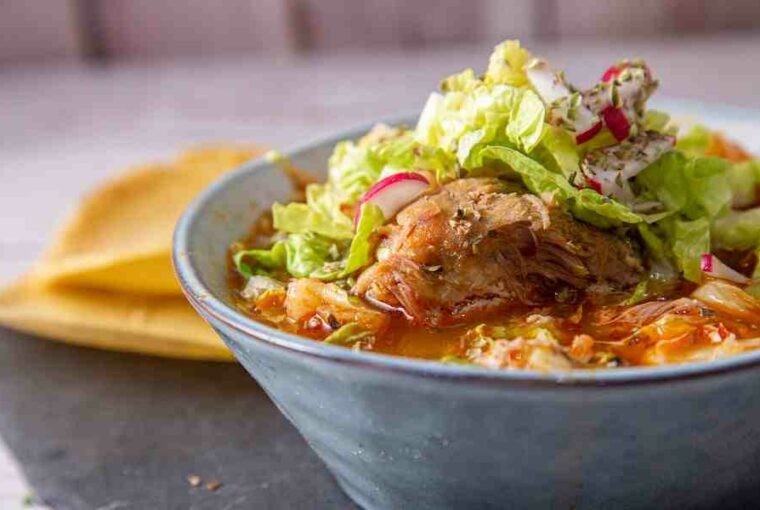The origins of Pozole are found in the ancient pre-Columbian cultures of Central America. Many different variations of this maize-based soup exist in that region, which is why it is not uncommon to find Pozole being served on different occasions and in various regions. In Mexico, Pozole is usually eaten during autumn and winter as a main dish. It can also be found at parties and festivals since this delicious soup has become one of the symbols of Mexican gastronomy. The preparation process for pozole isn’t complicated; however, it does require some time and patience because you need to boil the corn for a few hours until it becomes soft enough to be pureed.
Is Pozole Healthy?
Yes, pozole is very healthy and nutritious. It is made from white or red corn that is cooked in a liquid with aromatic and seasoning herbs and spices. It is a one-pot dish that is easy to prepare and very filling.
Why Is Pozole Good For You?
1. Pozole is a good source of fiber and protein
Pozole is a complete meal since it has all the essential macro- and micronutrients. It is also a good source of vitamin C and E, B vitamins, and various minerals such as iron, copper, zinc, potassium, copper, manganese, magnesium, and phosphorus.
2. Pozole is low in fat and cholesterol
It does contain small amounts of saturated fat due to the use of pork lard for frying the meat (which contains about 15% saturated fat). The amount of cholesterol in pozole is also low because it’s made from pureed corn kernels that do not contain cholesterol.
3. Pozole is a good source of dietary fiber
Pozole is a very filling and satisfying dish due to its high fiber content. It is rich in dietary fiber, which helps to lower cholesterol and maintain digestive health.
4. Pozole is good for the heart and blood vessels
Pozole is a very nutritious dish that contains many health-promoting compounds such as antioxidants and bioflavonoids. It also has a beneficial effect on the heart since it helps to maintain proper cholesterol levels in the blood. Pozole is a good source of iron, which is an important nutrient for the blood and helps to maintain hemoglobin levels.
5. Pozole is rich in vitamins
It contains various vitamins such as vitamin A, B1, B2, B3, B6, C, D, E, and K. The amount of vitamin A in pozole is higher than other similar dishes since it contains dried red chiles (which are rich in vitamin A).
6. Pozole is low in sodium
Pozole contains only a small amount of sodium, which is beneficial for health since it helps to maintain healthy blood pressure levels and prevents the occurrence of hypertension
7. Pozole is a good source of dietary minerals
Pozole contains various minerals such as iron, copper, phosphorus, magnesium, manganese, zinc, potassium, and selenium that are essential for maintaining a healthy body and preventing cardiovascular diseases such as high blood pressure and atherosclerosis.
8. Pozole is good for the eyesight
It helps to maintain proper eye health by maintaining the normal function of the lens in the eye (which helps to keep vision clear). It also contains many antioxidants that help to reduce free-radical damage to cells in the body that can lead to various chronic diseases (such as cancer).
How To Make Pozole
Shuck the corn
A large bowl, a pair of shears, and a few minutes are all that’s needed to remove the kernels from a dozen ears. You can use frozen or canned hominy if you don’t have time to shuck corn. If you do have the time, however, shucking corn is a relaxing and rewarding activity. You can even make it into a quick social activity by inviting some friends over and having a corn-shucking party. When you’re shucking corn, be careful not to accidentally scrape your hand with the shears. If you have thicker gloves, you can use those to protect your skin. Keep in mind that you’ll also need to remove the silk from the corn once you’ve shucked it. There are many different ways to do this, but the easiest way is to simply hold the corn upright over a bowl and gently shake the kernels out.
Prepare the rue and other ingredients
The meat is the only ingredient that will be cooked before adding it to the pozole. Cut a 2-pound pork butt into large chunks. You want the pieces to be large enough to not completely dissolve into the pozole; on the other hand, you don’t want them to be so large that they’re tough or inedible. Peel and mince a medium-sized onion. Wash 3 cloves of garlic and finely chop them as well. Combine the onion and garlic with 2 dried red chili peppers. A teaspoon each of ground cumin and oregano is a good amount to add.
Add the meat, seasonings, and spices
Heat the oil in a large pot over medium heat. Add the onion, garlic, and chili peppers. Cook the mixture for a few minutes until the onion is softened and translucent. Add the pork and cook until the meat is browned on all sides. While the meat is cooking, mix a 12-ounce bag of hominy (preferably yellow hominy) with 8 cups of water in a large pot. Add salt, to taste. Bring the water to a boil, then reduce the heat to maintain a gentle simmer.
Cook the pork and hominy
After the meat is browned, add the seasonings to the pot. Stir until the meat is completely covered and coated with the spices. Add the water/hominy mixture and stir to combine. Turn the heat to high and bring the liquid to a boil. Once it’s boiling, turn the heat to low and continue simmering for about 2 hours until the pork is tender enough to fall apart. Stir the pot every 20 minutes or so to keep the hominy from sticking to the bottom.
Add the remaining ingredients
Add 2 cups of chopped cilantro and 6 cups of water to the pozole. Stir to combine, then bring the mixture back to a boil. Reduce the heat to low, cover the pot, and simmer for an additional 15 minutes. While the pozole is simmering, slice a dozen corn tortillas into thin strips. Toast the strips over an open flame until they’re crispy. If you have access to an open flame, you can also char the corn husks over the fire.
Garnish and serve your pozole
For a traditional finishing touch, garnish the pozole with a few slices of radish and serve it with several dollops of fresh chopped cilantro, a few slices of lime, and a sprinkle of salt. Serve the pozole in large bowls or pottery mugs. If you want guests to be able to see the pozole, you can also serve it in clear glass or plastic glasses.
The Health Benefits Of Pozole
- Pozole is a traditional dish that has helped people since ancient times. It’s a hearty, filling dish that’s easy to cook and very inexpensive.
- The hominy in pozole is high in protein, particularly the non-GMO variety. This makes it an excellent source of amino acids and other essential nutrients.
- The fat content of the pork is high, which makes it one of the most heart-healthy meats you can eat. The fat also helps keep your blood sugar stable, making pozole a great choice for diabetics who need to keep their blood sugar levels in check or those with hypoglycemia (low blood sugar).
- Pozole is low in calories, which makes it a good choice for people who want to lose weight or maintain their current weight range without feeling hungry all the time.
The Health Disadvantages Of Pozole
- Pozole is high in sodium, which is the most common cause of high blood pressure (hypertension). It’s also one of the most common causes of stroke and heart failure.
- Pozole is one of the highest sources of cholesterol and fat in your diet, which can cause unhealthy cholesterol levels and weight gain. The fat in pozole is mostly saturated, which means it tends to raise your cholesterol levels and contribute to weight gain. This can be a major problem for people with high cholesterol or those who are pre-diabetic or diabetic. High blood pressure and diabetes are two other diseases that can be caused by too much saturated fat intake.
- Pozole has a relatively low amount of protein compared to other dishes, which makes it an inadequate source for vegetarians who need more protein in their diet to maintain muscle mass as they age or grow older.
Conclusion
Pozole is a nutritious Mexican soup that is usually eaten during autumn and winter. It is rich in vitamins and minerals and is low in calories, making it a good food choice for people who are trying to lose weight and improve their health. While many people claim that pozole is healthy, it is important to note that it is also a high-glycemic food that can spike your blood sugar levels. That being said, pozole is a good choice of food for people who are trying to lose weight since it is low in calories. It is also rich in vitamins and minerals, which can help boost your immune system and prevent you from getting sick.




